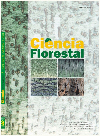
|
Ciência Florestal
Centro de Pesquisas Florestais - CEPEF, Departamento de Ciências Florestais - DCFL, Programa de Pós Graduação em Engenharia Florestal - PPGEF
ISSN: 0103-9954
EISSN: 0103-9954
Vol. 24, No. 4, 2014, pp. 967-976
|
 Bioline Code: cf14091
Bioline Code: cf14091
Full paper language: English
Document type: Research Article
Document available free of charge
|
|
|
Ciência Florestal, Vol. 24, No. 4, 2014, pp. 967-976
| en |
INFLUENCE OF THE ANGLE BETWEEN APPLIED FORCE AND WOOD GRAIN DIRECTION ON SHEAR STRENGTH
Logsdon, Norman Barros; Finger, Zenesio & de Jesus, José Manoel Henriques
Abstract
Wood is an anisotropic material and its resistance characteristics vary with the angle between the effort and
the fiber direction (α). The Brazilian Code NBR 7190 – Design of Wooden Structures, foresees the strength
correction to the normal stress, whenever α > 6°, and it recommends to apply Hankinson’s expression
to design values. However, this referred code is omitted about this correction to the tangential stress.
Besides, there is not experimental confirmation about the validity of using this expression on design values,
originating from characteristic values. The objectives of this work were: to search in the bibliography
other used expressions; to verify the validity of these expressions, to represent the variation of the shear
strength, with the α angle; and, to verify the validity of application of these expressions in characteristic
values. For this, a sample formed by twelve boards was used. From each board, specimens to shear tests
were retired, with different fibers inclinations, which were tested in agreement with current NBR 7190,
supplying the shear strength, for different α values. Four models (Hankinson, Sin, Karlsen and Keylwerth)
were evaluated, using the pairing and deviation tests. The model that best represented the phenomenon, in
both cases, was Keylwerth’s.
Keywords
shear strength; characteristic strength; fibers inclination
|
| |
| pt |
INFLUÊNCIA DO ÂNGULO ENTRE O ESFORÇO APLICADO E A DIREÇÃO DAS FIBRAS DA MADEIRA SOBRE A RESISTÊNCIA AO CISALHAMENTO
Logsdon, Norman Barros; Finger, Zenesio & de Jesus, José Manoel Henriques
Resumo
A madeira e um material anisotropico e suas caracteristicas de resistencia variam com o angulo entre
o esforco e a direcao das fibras (α). A norma brasileira NBR 7190 . Projeto de Estruturas de Madeira
preve a correcao da resistencia as tensoes normais, sempre que α > 6°, e recomenda aplicar a expressao
de Hankinson aos valores de calculo. Entretanto, a referida norma e omissa sobre esta correcao as tensoes
tangenciais. Alem disso, nao ha comprovacao experimental sobre a validade de utilizar esta expressao
em valores de calculo, oriundos de valores caracteristicos. Foram objetivos deste trabalho: pesquisar na
bibliografia outras expressoes utilizadas; verificar a validade destas expressoes para representar a variacao
das resistencias ao cisalhamento com o angulo α e verificar a validade de aplicacao destas expressoes em
valores caracteristicos. Para isto, utilizou-se uma amostra formada por doze pranchas de madeira. De cada
prancha foram retirados corpos de prova de cisalhamento, com diferentes inclinacoes das fibras, que foram
ensaiados em acordo com a atual NBR 7190, fornecendo as resistencias ao cisalhamento, para diferentes
α. Quatro modelos (Hankinson, Senos, Karlsen e Keylwerth) foram avaliados, utilizando-se os testes de
pairing e dos desvios. O modelo que melhor representou o fenomeno, nos dois casos, foi o de Keylwerth.
Palavras-chave
resistência ao cisalhamento; resistência característica; inclinação das fibras
|
| |
© Copyright 2014 - Ciência Florestal
Alternative site location: http://cascavel.ufsm.br/revistas/ojs-2.2.2/index.php/cienciaflorestal/index
|
|
